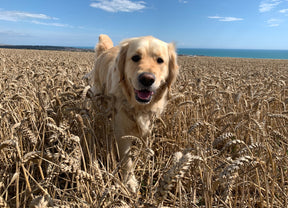
An introduction to the canine microbiome
The community of organisms that live within the digestive tract are known as the gut microbiome, and there are literally trillions of them.
Read articleGet started with our Free Gut Health Check.

Your dog’s BIOME9 report may suggest some changes to your dog’s diet based on the results of their microbiome analysis and any specific issues that have been identified. If you decide to make any changes to their diet, it’s important to do so carefully and gradually to avoid the risk of digestive upsets as their system becomes accustomed to the new foods. Here’s our quick guide to making dietary changes safely and effectively:
If you are adding in new ingredients, such as vegetables for added fibre, or eggs for protein, start with small amounts well mixed in to your dog’s usual diet and gradually increase the quantity over 3-4 days to allow them plenty of time to get used to the taste and for their digestive system to adjust to the new ingredients.
If you notice any negative changes to their digestive function, such as loose motions or diarrhoea, or a reduction in appetite, reduce the quantity of the new ingredient for a few days before trying again. If the same issue recurs, then it is best to look for alternative ingredients or other dietary options rather than cause prolonged dietary upsets.

If you decide to make more significant changes to your dog’s diet, such as changing from one type of feeding to another, or even switching between brands, it’s important to manage the transition period carefully to avoid digestive upsets and risk your dog not settling on their new diet.
The ideal way to transition your dog from one food to another is to gradually transition them over 7-10 days, increasing the amount of their new diet slowly over this period:
Keep a careful eye on your dog’s reaction to the new diet during this period, looking out for signs of digestive distress, such as vomiting, diarrhoea, or constipation. Also, observe your dog's energy levels and overall health, and if you notice any adverse reactions, slow down or reverse the process until they settle down. If any symptoms become serious or prolonged, consult your vet for advice.
When switching to a new diet, pay close attention to portion sizes to avoid overfeeding or underfeeding as the recommended feeding guide for the new food may be significantly different to the old one. For example, dry foods are much more calorie-dense than fresh or tinned foods, and so portions are much smaller.
The feeding guide that comes with the new diet is the best starting point, but be prepared to adjust the exact amount your feed according to how your dog responds as every dog is an individual and their exact energy requirements can vary significantly.
Remember, every dog is different, and what works for one may not work for another. Paying close attention to your dog's specific needs and responses is crucial for a successful diet change.
The microbiome is the name given to the collection of microbes, mostly bacteria, but also fungi and protozoa, that exist within your dog’s gut. It is a diverse and complex microbial community which can directly affect health and wellbeing. We know that 90% of a human’s body cells are microbes, with only 10% being human cells – it’s just that human cells are markedly larger than the microbes. It’s similar for our four-legged friends. Testing the microbiome gives us an idea of exactly which bacteria are present in your dog’s gut and this can help indicate existing or future health problems.
A healthy diversity within the microbiome has been found to be an accurate indicator of overall health and wellbeing. If your dog appears healthy, but has an imbalance in their microbiome, then this could be an indicator of a potential future health issue. If your dog has any existing health complaints, then improving the health of their microbiome can help to improve immune system health and overall wellbeing, as well as improving disease symptoms.
Testing and treatment have the potential to help with a whole range of different health complaints. The immune system is very closely associated with the gut, so any imbalance in the microbiome can influence immune system health, overall vitality and wellbeing. Our supplement recommendations are also tailored to your individual dog, with specific ranges designed to help with gastrointestinal inflammation, joint problems, allergies and skin complaints, to name a few.
All you need to do is order a kit online and fill in our questionnaire about your dog and their general health. We will then send the kit out to you by post. You then just need to collect a sample and return it to us, again by post. Once the test is performed, we will email the results directly to you.
You do not need to get your vet’s permission to test, or talk to them about performing the test beforehand. We do recommend that you pass on a copy of your test results to your regular vets, as it may help them in understanding your pet’s current health, and any future complaints they may have.
Get in touch with our team to talk about our microbiome test kit, precision supplements, and more.

The community of organisms that live within the digestive tract are known as the gut microbiome, and there are literally trillions of them.
Read article
Allergic disease makes up a large proportion of the reason dogs are brought to vets, particularly with conditions relating to the skin.
Read article
It is well accepted that the microbes in our dogs’ intestines can play a major role in the health of their joints and their mobility.
Read article
From live yoghurts to health supplements, these terms are used to describe the active ingredients that claim to be able to transform the health of the microbiome.
Read article